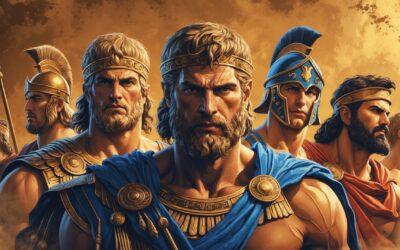- Deep Dive Intro
- A Landscape of War and Humanity
- Love Amidst the Carnage: Robert and María
- The Weight of Duty and Moral Choices
- Hemingway’s Distinctive Style: Sparse Prose, Powerful Impact
- Enduring Themes and Lasting Legacy
- Reading Comprehension Quiz
- Let’s Talk | Listening Comprehension Practice
- Listening Comprehension Quiz
- Let’s Learn Vocabulary in Context
- Vocabulary Quiz
- Let’s Discuss & Write
- Learn with AI
- Let’s Play & Learn
Deep Dive Intro
Ernest Hemingway, a literary titan whose prose resonated with a stark and profound honesty, gifted the world with numerous enduring works. Among these stands For Whom the Bell Tolls, a powerful and poignant novel that plunges readers into the heart of the Spanish Civil War. More than just a war story, this masterpiece delves into the complexities of human relationships, the weight of moral choices, and the enduring spirit of individuals caught in the maelstrom of conflict. It’s a book that lingers in the mind long after the final page is turned, its themes echoing with a timeless relevance.
Published in 1940, For Whom the Bell Tolls tells the story of Robert Jordan, an American volunteer fighting with the Republican forces. A skilled dynamiter, Jordan is tasked with a perilous mission: to blow up a crucial bridge behind enemy lines in the Guadarrama Mountains. Over the course of three intense days and nights, the novel unfolds, weaving together Jordan’s preparations for the mission with his burgeoning love for a young Spanish woman named María, and his interactions with a colorful and often fractious band of guerrilla fighters.
A Landscape of War and Humanity
Hemingway masterfully paints a vivid picture of the war-torn Spanish landscape, from the rugged mountains to the hidden caves that serve as the guerrillas’ sanctuary. But the true brilliance of the novel lies in its portrayal of the human beings caught in this brutal conflict. We encounter a diverse cast of characters, each with their own motivations, fears, and loyalties. There’s Pilar, the formidable and wise woman who leads the guerrilla band with unwavering strength; Agustín, the fiercely loyal and often cynical comrade; Anselmo, the old and stoic guide whose wisdom is rooted in a deep connection to the land; and Rafael, the unreliable and self-serving member of the group.
Through their interactions, Hemingway explores the intricate bonds that form in the face of shared adversity. Loyalty to the cause, to one’s comrades, and to newfound love are tested and redefined in the crucible of war. The novel doesn’t shy away from the brutality and senselessness of conflict, yet it also illuminates the moments of profound human connection, courage, and even humor that can emerge in the darkest of times.
Love Amidst the Carnage: Robert and María
At the heart of the novel is the tender and passionate love story between Robert Jordan and María. Their connection is immediate and intense, a beacon of hope and humanity amidst the surrounding chaos. María carries the scars of the war, having witnessed and endured unspeakable atrocities. In Jordan, she finds solace, understanding, and a renewed sense of life. Their love affair, though brief, is portrayed with a raw and poignant beauty, highlighting the preciousness of human connection in the face of imminent danger.
Hemingway’s depiction of their relationship is both sensual and deeply emotional, exploring the profound impact they have on each other in a compressed timeframe. Their conversations are filled with a longing for a future that may never come, yet they find solace and strength in the present moment. Their love becomes a powerful symbol of resilience and the enduring human need for connection, even in the face of death.
The Weight of Duty and Moral Choices
Robert Jordan’s mission to blow up the bridge is the central driving force of the plot, and it raises profound questions about duty, sacrifice, and the cost of war. Jordan is a man torn between his commitment to the Republican cause and his growing desire to live and build a life with María. He grapples with the moral implications of his actions, understanding the human cost of the destruction he is about to unleash.
The novel explores the complexities of fighting for a cause, even when the lines between right and wrong become blurred. Jordan’s internal struggles reflect the broader dilemmas faced by individuals in times of conflict, forcing readers to consider the sacrifices they might be willing to make for their beliefs.
Hemingway’s Distinctive Style: Sparse Prose, Powerful Impact
For Whom the Bell Tolls is a prime example of Hemingway’s signature writing style: concise, direct, and emotionally resonant. His sentences are often short and declarative, stripped of unnecessary adjectives and adverbs. This sparse prose creates a sense of immediacy and realism, drawing the reader directly into the characters’ experiences.
Hemingway’s use of dialogue is particularly effective in revealing character and advancing the plot. The conversations between the guerrillas are often filled with their unique vernacular and reflect their diverse personalities and backgrounds. The repetition of certain phrases and ideas, like the recurring question of “How goes it?”, adds to the novel’s rhythmic and almost lyrical quality.
Enduring Themes and Lasting Legacy
Despite being set during a specific historical conflict, For Whom the Bell Tolls explores universal themes that continue to resonate with readers today. The novel delves into the nature of courage, the importance of human solidarity, the devastating impact of war, and the enduring power of love in the face of adversity.
The title itself, taken from a sermon by John Donne, emphasizes the interconnectedness of humanity: “No man is an island, entire of itself; every man is a piece of the continent, a part of the main… any man’s death diminishes me, because I am involved in mankind; and therefore never send to know for whom the bell tolls; it tolls for thee.” This profound message underscores the novel’s exploration of shared human experience and the understanding that the suffering of one affects all.
For Whom the Bell Tolls remains a powerful and important work of literature, offering readers a visceral and thought-provoking glimpse into the human cost of war and the enduring strength of the human spirit. Its compelling characters, vivid setting, and profound themes have secured its place as an immortal work, continuing to challenge and move readers decades after its publication. It serves as a potent reminder of the importance of empathy, the fragility of peace, and the enduring power of love and loyalty in a world often fractured by conflict.
Reading Comprehension Quiz
Let’s Talk | Listening Comprehension Practice
Listening Transcript: Please don’t read the transcript before you listen and take the quiz
So, we just took a journey into the heart of the Spanish Civil War with Hemingway’s For Whom the Bell Tolls. Heavy stuff, right? It really makes you think about what it means to be caught up in something bigger than yourself, whether it’s war, a social movement, or even just a really intense personal crisis.
What struck me most about the book, and maybe you felt this too, was how Hemingway managed to make these characters feel so real, even amidst all the chaos and violence. You had Robert Jordan, this American guy who volunteers to fight for a cause he believes in, but he’s also just trying to find some connection and meaning in the middle of all this destruction. And then there’s María, who’s been through so much trauma, but still finds this incredible capacity for love and hope.
And the relationships between all the guerrillas – it’s like they’re a family forged in fire. They bicker, they have their disagreements, but at the end of the day, they’re all relying on each other for survival. Pilar, especially, stands out as this incredibly strong and wise figure, holding them all together. It makes you wonder about the bonds that people form when they’re facing really tough times together. Have you ever experienced something like that, where you felt incredibly close to people because you were all going through the same difficult situation?
I also found myself thinking about the whole idea of fighting for a cause. Robert Jordan believes in the Republican cause, but he also wrestles with the morality of what he’s doing – blowing up a bridge, knowing people will die. It brings up this really complex question: when is it okay to take violent action in the name of a greater good? It’s something that’s still relevant today, with so many conflicts and social issues happening around the world. Where do you draw the line? What are you willing to fight for, and what are the costs you’re willing to accept?
And then there’s the love story between Robert and María. It’s so intense and happens over such a short period of time. It almost feels like because they’re facing death, their emotions are heightened, and they connect on this really deep level. It makes you think about how precious and fragile human connection can be, especially in the face of uncertainty. Have you ever felt a really strong connection with someone in a short amount of time, maybe during a trip or some kind of intense experience?
Hemingway’s writing style is so distinctive too, right? It’s so spare and direct, but he manages to convey so much emotion with just a few words. It’s like he trusts the reader to fill in the gaps and understand the underlying feelings. It’s a really powerful way of writing, and it definitely makes the story feel more immediate and real.
One thing that the book really highlights is the human cost of war. It’s not just about the battles and the strategies; it’s about the individual lives that are affected, the families that are torn apart, the trauma that people carry with them long after the fighting stops. It makes you appreciate the importance of peace and understanding, and it makes you think about the responsibility we all have to prevent conflict whenever possible.
Have you ever read a book that really changed your perspective on something, like war or love or loyalty? What was it about that book that had such an impact on you? I think For Whom the Bell Tolls is one of those books for a lot of people. It’s not always an easy read, but it definitely leaves you with a lot to think about.
And what about the ending? Without giving too much away, Robert makes a pretty significant choice. It’s a decision that speaks to his sense of duty and his love for María and his comrades. It’s a powerful and ultimately tragic ending. What did you make of his decision? Do you think it was the right one? What would you have done in his situation?
These are just some of the thoughts that came to my mind after reading For Whom the Bell Tolls. It’s a book that really stays with you, and I think that’s why it’s considered a classic. It deals with these timeless themes of love, loss, loyalty, and the human condition in a way that feels just as relevant today as it did when it was written.
Listening Comprehension Quiz
Let’s Learn Vocabulary in Context
Alright, let’s delve into some of the rich vocabulary that Hemingway weaves into For Whom the Bell Tolls. These aren’t just fancy words thrown in for show; they really help to create the atmosphere and deepen our understanding of the characters and their experiences.
First, we encounter the word maelstrom. When I described the Spanish Civil War as a maelstrom, I was referring to a powerful and chaotic situation, like a giant whirlpool that sucks everything in. War, with its violence and upheaval, is certainly a maelstrom of human emotion and destruction. You might also use maelstrom to describe a period of intense personal turmoil or a chaotic event like a natural disaster.
Then there’s the word poignant. I used it to describe the novel as a poignant story, and also to describe the beauty of Robert and María’s love. Poignant means deeply moving or touching, often in a sad or melancholic way. A poignant memory might bring tears to your eyes, or a poignant farewell scene in a movie can leave a lasting emotional impression.
We also see the word fractious used to describe the band of guerrilla fighters. A fractious group is one that is easily irritated, bad-tempered, and likely to argue or disagree. In the stressful and dangerous environment of the war, it’s understandable that the guerrillas might become fractious at times. You might describe a family gathering with a lot of disagreements as fractious.
Another word that stands out is formidable, which I used to describe Pilar. Formidable means inspiring fear or respect through being impressively large, powerful, intense, or capable. Pilar’s strong leadership and presence make her a formidable figure within the group. A formidable opponent in a game is someone you know will be very difficult to beat.
We also have the word stoic, which I used to describe Anselmo. A stoic person is someone who can endure hardship and pain without showing their feelings or complaining. Anselmo’s quiet strength and resilience in the face of the war make him a stoic character. Someone who remains calm and composed during a crisis might be described as stoic.
The word burgeoning came up when I talked about Robert and María’s love. Burgeoning means beginning to grow or increase rapidly; flourishing. Their love develops quickly and intensely in a short period, so it’s a burgeoning romance. You might talk about a burgeoning business that is starting to become very successful.
I used the word crucible to describe the war as a crucible in which loyalties are tested. A crucible is a situation of severe trial, or a place or situation in which different elements are mixed and undergo transformation. The intense pressures of war act as a crucible, revealing the true nature of the characters. Difficult life experiences can also be seen as a crucible that shapes who we become.
The word visceral is a great one. I used it to describe the glimpse the novel offers into the human cost of war. Visceral means relating to deep inward feelings rather than to the intellect. A visceral reaction is one that is felt strongly in your gut, an immediate and powerful emotional response. A truly impactful movie scene might evoke a visceral reaction in the audience.
Then we have the word mausoleum. While not used in direct reference to a person in our discussion, the idea of a mausoleum as a large and impressive tomb is relevant to the themes of death and remembrance in the novel. A mausoleum is a building, especially a large and stately one, housing a tomb or tombs. Visiting a historical mausoleum can be a somber and reflective experience.
Finally, let’s look at maelstrom again, as it’s a powerful image. Remember, it signifies chaos and turbulence. The political climate of a country on the brink of revolution could be described as a maelstrom. Or, on a smaller scale, a crowded marketplace during a festival might feel like a maelstrom of people and activity.
These words and phrases really add depth and color to our understanding of For Whom the Bell Tolls. By paying attention to how Hemingway uses them, we can gain a richer appreciation for the novel’s themes and the experiences of its characters. Hopefully, you can find ways to weave these words into your own vocabulary as well!
Vocabulary Quiz
Let’s Discuss & Write
Alright, now that we’ve journeyed through the vocabulary and the core of For Whom the Bell Tolls, let’s open up the discussion a bit further. Here are some questions to ponder and perhaps share your thoughts on:
- Hemingway often explores themes of courage and cowardice in his work. How are these themes portrayed in For Whom the Bell Tolls through the actions and motivations of different characters?
- The novel delves into the complexities of loyalty – loyalty to a cause, to comrades, and to loved ones. Which character’s sense of loyalty do you find most compelling or conflicted, and why?
- María’s character carries the heavy burden of trauma from the war. How does Hemingway depict the lasting impact of violence on individuals, and how does María find solace and connection with Robert Jordan?
- The Spanish Civil War was a conflict with significant ideological underpinnings. While the novel focuses on the personal experiences of the characters, how does it subtly (or not so subtly) portray the broader political and social context of the war?
- Hemingway’s ending for Robert Jordan is both heroic and tragic. What is your interpretation of his final decision? Do you see it as an act of ultimate sacrifice or something else?
Now, let’s get those creative writing muscles working with this prompt:
Writing Prompt:
Imagine you are one of the minor characters in For Whom the Bell Tolls – perhaps one of the other guerrilla fighters in Pablo’s band, or a villager who interacts briefly with Robert Jordan.
Directions:
- Choose a minor character from the novel and write a short journal entry from their perspective, reflecting on their experiences during the three days and nights covered in the book.
- Focus on their observations and feelings about Robert Jordan, María, Pilar, or any of the key events that unfold.
- Try to capture the tone and atmosphere of the novel in your writing. Consider using Hemingway’s concise and direct style.
- Explore the character’s inner thoughts and feelings, perhaps shedding light on aspects of the story that weren’t explicitly detailed in the main narrative.
Tips and Sample Phrases:
- To begin, you might set the scene: “The American, Roberto, he is strange but strong. He speaks our tongue poorly, but his eyes, they see much.”
- When describing Robert Jordan’s mission: “Pablo, he grumbles about the bridge. But Pilar, she says it must be done. There is a fire in her voice that burns even brighter than the enemy’s guns.”
- Reflecting on María: “The girl, María, she is like a wounded bird. But with Roberto, I see a flicker of life return to her eyes.”
- Expressing fear or uncertainty: “The fascists, they are close. We can feel them in the wind. I pray to God we survive this night.”
- Considering the bonds within the group: “We are few, but we are together. We have seen too much to ever be truly alone again.”
- You could also use phrases like: “I remember the day…”, “The air was thick with…”, “His words were few, but…”, “She looked at him with…”, “We all knew that…”
Dive into the world of For Whom the Bell Tolls from a new perspective and let your chosen character’s voice guide your writing. I’m eager to see your interpretations!
Learn with AI
Disclaimer:
Because we believe in the importance of using AI and all other technological advances in our learning journey, we have decided to add a section called Learn with AI to add yet another perspective to our learning and see if we can learn a thing or two from AI. We mainly use Open AI, but sometimes we try other models as well. We asked AI to read what we said so far about this topic and tell us, as an expert, about other things or perspectives we might have missed and this is what we got in response.
Stepping into the role of an expert on For Whom the Bell Tolls, I think it’s important to highlight a few nuances that we might have only touched upon or even missed in our discussion so far.
One fascinating aspect of the novel is Hemingway’s use of interior monologue, particularly with Robert Jordan. We get deep access to his thoughts, his memories, and his reflections on the war, love, and death. This technique allows us to understand his motivations and his internal struggles in a very intimate way. It’s not just about what he says or does, but what’s going on inside his head that truly shapes his character and his decisions. This stream of consciousness gives the novel a psychological depth that goes beyond the surface narrative.
Another point worth considering is the symbolism woven throughout the book. The bridge itself is an obvious symbol of strategic importance in the war, but it also represents a point of no return for Robert Jordan. The act of blowing it up signifies his commitment to the cause and ultimately leads to his demise. The changing weather in the mountains can also be seen as symbolic, reflecting the shifting fortunes of the war and the emotional states of the characters. Even the rabbits that María fears can be interpreted as a symbol of vulnerability and the ever-present threat of danger.
We also shouldn’t overlook the linguistic landscape of the novel. Hemingway makes a deliberate choice to have the Spanish characters speak in English, but he infuses their dialogue with Spanish idioms and sentence structures. This creates a unique and somewhat stylized way of representing their speech, giving the reader a sense of being immersed in the Spanish setting without requiring them to learn a new language. It’s a literary device that adds to the novel’s atmosphere and authenticity, although it has been a subject of some critical debate over the years.
Furthermore, the novel offers a nuanced portrayal of the political complexities of the Spanish Civil War, even though it primarily focuses on the individual experiences of the characters. While Robert Jordan clearly sides with the Republican cause, Hemingway doesn’t shy away from depicting the internal conflicts and moral ambiguities within the Republican ranks. Characters like Pablo represent a more cynical and self-preserving perspective, highlighting the fact that even within a seemingly unified cause, there can be conflicting motivations and ideologies.
Finally, I think it’s crucial to acknowledge the historical context in which the novel was written. Published in 1940, as World War II was raging in Europe, For Whom the Bell Tolls can be seen as Hemingway’s reflection on the nature of war and its impact on humanity in a broader sense. The themes of anti-fascism and the importance of collective action against oppression resonate strongly with the historical period in which the novel was created. Understanding this context can deepen our appreciation for the novel’s message and its enduring relevance. These are just a few additional layers to consider when engaging with this powerful and multifaceted work of literature.










0 Comments